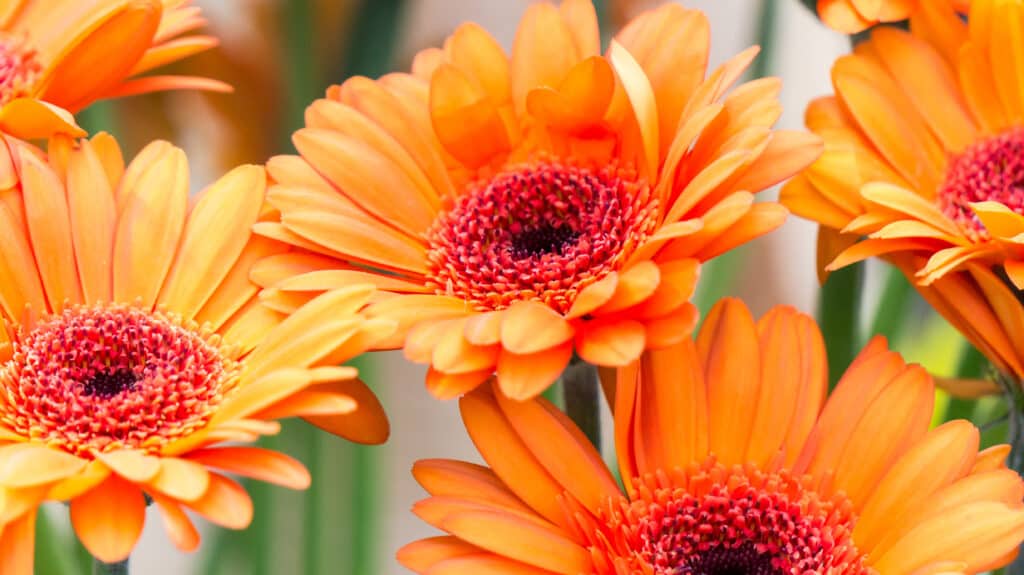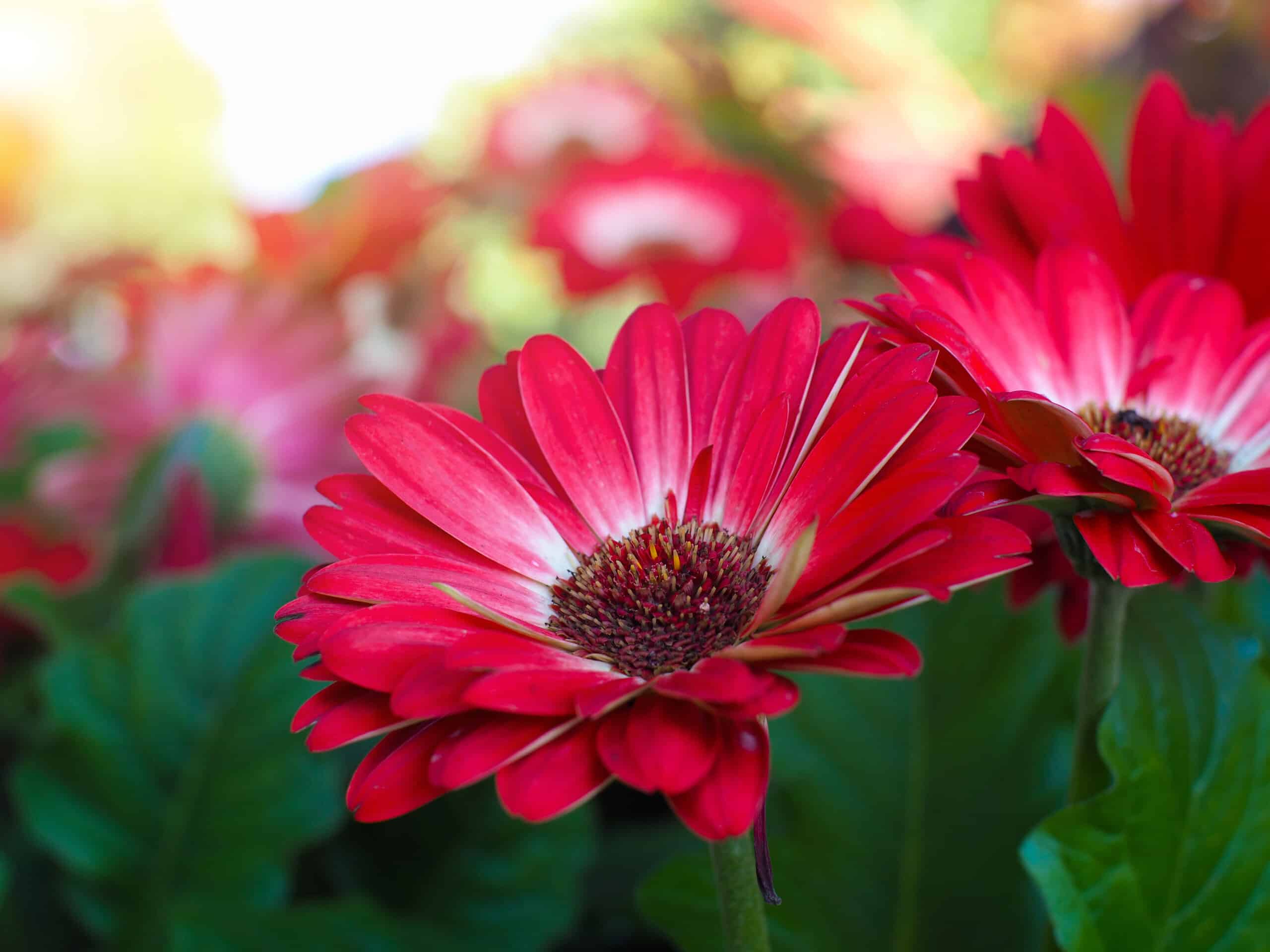Do you gravitate toward daises in the store or at a nursery? If so, it’s understandable. These bright flowers tend to bring a smile to everyone’s face. And there are countless varieties to choose from if you want to try growing some daises at home. So, how do you pick one? Learning about different species and their care needs is a good first step. Here, we will take a deep dive into gerbera daisies (Gerbera jamesonii). These beauties are a big hit among gardeners and flower enthusiasts. And you can join their ranks as soon as you get armed with a little information. Below, we offer a complete plant care guide for the gerbera daisy. They will help you cultivate these stunning plants successfully.
What Are Gerbera Daisies?
Gerbera daisies are a perennial flower native to South Africa but are a global favorite. They belong to the aster family. These large, bright, colorful flowers come in a shocking number of colors. You may find include: red, pink, salmon, lavender, yellow, white, and orange.
They have a basal rosette of leaves and long stems that can reach as tall as 6 to 18 inches (15 to 45 cm). But their height is not the most impressive part. Instead, it’s the plant as a whole. Each grows between 12 and 15 inches (30 to 38 cm) wide. And the individual flowers are up to 4 inches (10 cm) wide.

Gerbera daisies come in bright, vivid colors.
©Andrey Shepetov/Shutterstock.com
Are There Any Gerbera Daisy Cultivars?
Yes! There are lots of cultivars for you to choose from. You may find over a dozen different varieties, depending on your location. A few to keep an eye out for include:
- ‘Pink and White Linosa’
- ‘Yellow Lampione’
- ‘Mardi Gras’
- ‘Orange Palmaria’
- ‘Red Rafinee’
- ‘Rainbow’
How Do You Care For Gerbera Daisies?
You fell in love with a gerbera daisy and happily brought one home. Now, how do you ensure its healthy growth and longevity? Thankfully, you can keep your beautiful flowers looking good and producing gorgeous blossoms with the appropriate care. Here are detailed tips to help you cultivate these beautiful plants:
Light Requirements
Gerbera daisies do best in full sunlight. So, getting them a solid six hours of direct sunlight daily is best. But don’t worry. You can still successfully grow these lovely flowers in areas that don’t receive that much sun. Gerbera daisies can survive in partial shade. As long as you can find a spot that gets between two to six hours of direct light, they will grow well.
It is also possible to grow these daisies inside in containers if you prefer or lack access to an outdoor space. If you do so, place them near a south-facing window to maximize sun exposure. But most indoor settings do not get adequate natural light. That is easy to compensate for. Simply supplement with artificial grow lights.
Proper light is vital for strong stem development and vibrant flower production. So focus on this aspect before anything else.
Soil and Watering
Gerbera daisies prefer clay-based or loaming soil as long as it is well-draining. They also require soil with a high organic matter content. Don’t be shy about mixing compost into the soil before planting. Alternatively, add a small scoop of compost to each hole before transplanting your daisies.
Ensure the soil is well-draining. Gerbera daisies are particularly prone to root rot and crown disease if their home is too water-logged. If you do not have an in-ground space that drains well, opt for a container or raised garden bed instead.
Watering gerbera daisies is a little tricky. It is important to water the plants regularly. Allow the soil to dry out slightly between waterings. And be cautious not to overwater. Aim to maintain consistently moist soil without waterlogging.
Temperature and Humidity
Gerbera daisies thrive in moderate temperatures, which is why they do best in USDA Hardiness Zones 8-10. While they can tolerate slightly higher temperatures, they may suffer in extreme heat. They can survive in these hotter environments. But they would need a spot with more shade and less direct sunlight. Additionally, it would require more attentive monitoring of the moisture level of the soil.
It is also crucial to provide adequate air circulation to prevent humidity-related diseases. As long as you space your plants properly (roughly 12 to 18 inches apart), this should offer enough breathing room.
Fertilization
It is important to feed your Gerbera daisies with a balanced, water-soluble fertilizer to promote healthy growth and abundant blooms. During the growing season, apply the fertilizer every two to three weeks. Look for a fertilizer specifically formulated for flowering plants and follow the package instructions for application rates.
And if you can find a fertilizer that contains manganese and iron, pick some up. Gerbera daisies feed heavily on these nutrients. So the soil can get depleted easily.
Pruning and Deadheading
Regular pruning and deadheading are essential for maintaining the health and appearance of Gerbera daisies. Deadheading involves removing spent flowers to encourage continuous blooming. Cut the stem just above the base of the plant to prevent seed production and redirect the plant’s energy into producing new blooms.
Pruning any damaged or yellowing leaves will help maintain a tidy appearance and prevent the spread of diseases.

With proper deadheading, your flowers will continue blooming into thick and beautiful plants.
©Sun Shock/Shutterstock.com
Pests and Diseases
Gerbera daisies are generally resistant to pests and diseases. However, they can occasionally be affected by aphids, thrips, spider mites, and whiteflies. Some diseases to watch for are gray mold or powdery mildew. Monitor plants regularly to detect any signs of infestation or disease.
Apply neem oil or insecticidal soap if you detect any insects. And quickly remove any damaged leaves to prevent the spread of disease.
Propagation
Gerbera daisies can get propagated through division or seed sowing.
Carefully separate the plant’s clumps in early spring or fall to propagate using division. Ensure that each division has healthy roots and shoots for successful establishment.
Seed sowing is another option for propagation. Collect mature seeds from the flower heads and sow them in well-draining soil. Keep the soil consistently moist until germination occurs.
Mulching
Applying a layer of organic mulch around the base of the plants offers numerous benefits. Mulching helps conserve moisture, suppress weeds, and regulate soil temperature. Use organic materials such as straw, bark chips, or compost as mulch. Be sure to leave a small gap around the stems to prevent rotting.
Support and Staking
It isn’t critical to support (or stake) your Gerbera daisies. But it may help prevent taller plants from damage due to heavy winds. Gently tie the stems to the stakes using soft garden twine or plant ties.
Pinching
Pinching is a technique that involves removing the growing tip of the plant to encourage branching and bushier growth. Pinch off the top of each stem just above a leaf node when your Gerbera daisies reach a height of about 6 inches (15 cm). Doing so will produce more compact and fuller plants with increased flower production.
Seasonal Care
Gerbera daisies may benefit from protection against frost and cold temperatures during the winter. Cover the plants with mulch or bring potted plants indoors if you are growing them outdoors in a cold climate. Reduce watering during the dormant period to prevent root rot and give the plants time to rest.
So, if you live in a colder climate, don’t write off this gorgeous plant. You can still successfully grow it year-round, but it will take some extra care.

With proper care, your Gerbera daisy blossoms will grow into stunning flowers.
©Greens and Blues/Shutterstock.com
Thank you for reading! Have some feedback for us? Contact the AZ Animals editorial team.








